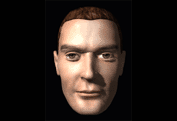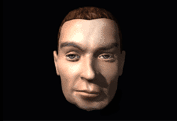

Maybe it's the tiny chin, or the large, wide-open eyes. Or those soft, chubby cheeks. Whatever the attraction, a crowd of normally stoic strangers has suddenly gathered 'round to speak in sing-song and make faces worthy of clowns-for-hire.
 Such
is the magnetic power of a baby.
Such
is the magnetic power of a baby.
Yet, precisely what is it about a baby's looks that disarms even the most unwilling?
Size is an obvious giveaway, but research has shown that in addition to an infant's small size, other critical differences in physical appearance seem to elicit warm, affectionate and protective responses: an infant's large eyes and pupils, full cheeks, fine, high eyebrows, and pug nose. These uniquely infantile features serve as key stimuli: specific components of appearance or behavior that can elicit favorable responses -- with obvious and very necessary implications for the survival of the very young.
The human response to the key stimuli for babyishness is so strong, however,
that it also extends to animals and cartoon characters, as well as to
adults in whom these stimuli appear. It has long been assumed that baby-faced
adults elicit very different social responses than do their more mature-faced
peers; witness the profusion of pop icons and idols bearing baby-faced
features. But baby-oriented assumptions are not the only thing we perceive in a face.
 It has long been assumed that one can judge all manner of psychological
traits from a person's face, as in the case of the "wide-eyed innocent"
or the "beady-eyed criminal."
And the assumption that the face betrays emotion rings true whenever the phrase "wipe that look off your face"
or "don't give me that look" is uttered. But assumptions do not science
make.
It has long been assumed that one can judge all manner of psychological
traits from a person's face, as in the case of the "wide-eyed innocent"
or the "beady-eyed criminal."
And the assumption that the face betrays emotion rings true whenever the phrase "wipe that look off your face"
or "don't give me that look" is uttered. But assumptions do not science
make.
Enter Dr. Leslie Zebrowitz, NSF-funded researcher and professor of psychology at Brandeis University. Via on-going research in her social perception laboratory, Dr. Zebrowitz is investigating why people who are forming first impressions of others based solely on facial characteristics reach a consensus in their impressions. Why do these observers show strong agreement when judging traits like warmth, intelligence, and dominance? The answer is far from obvious. One might think that the consensus supports the simple reality that those who look warm, intelligent or dominant actually are. However, previous research indicates that consensus among perceivers is considerably higher than the accuracy of their impressions. As any poker player knows, reading faces is not as easy as it looks.
Dr. Zebrowitz and her computer science collaborator, Dr. Jean-Marc Fellous, use two types of data to test the hypotheses -- data from computer modeling and data from human judges. "We use a computer technique called 'connectionist modeling' to determine whether two types of faces can be differentiated on the basis of a series of facial measurements," Dr. Zebrowitz explains. "For example, the computer is given measurements from babies' faces (e.g., nose length, eye size) and measurements from normal adults' faces. The computer's task is to 'learn' to differentiate between these two categories of faces." Once the computer has mastered this task so that it can correctly identify a baby and an adult simply from the facial measurements, generalization is assessed. More specifically, the computer model is given measurements made from normal adults' faces and the extent to which the computer confuses certain adults with real babies is assessed. Such confusion is viewed by the researchers as 'overgeneralization' by the computer.
Next, human judges are shown the same faces whose measurements were provided to the computer, and the judges are asked to form trait impressions. Dr. Zebrowitz can then determine whether the human impressions of these faces can be predicted from the overgeneralization shown by the computer. "For example, we can determine whether the tendency to perceive particular adults as warm can be predicted from the computer's confusion of those adults' faces with the faces of babies," Dr. Zebrowitz says. If the tendency can be predicted, than the babyface overgeneralization hypothesis is supported. The technique of computer modeling coupled with human judgments is also being applied to "fitness" and "emotion" hypotheses. (See sidebar)
Proving that human beings tend to "overgeneralize" in assessing another person's personality is an important first step toward ultimately addressing the myriad problems that arise when errors of judgment are made. Trusting a babyfaced stranger can be dangerous. Conversely, presuming that an angry-looking suspect is guilty of a crime can end in tragedy.
 In
her book, Reading Faces: Window to the Soul? Dr. Zebrowitz applies her
extensive experience in psychological research to an examination of two
facial qualities that influence our impressions of others immeasurably:
babyfaceness, the subject of much of her current research, and attractiveness,
which has received the most attention from psychologists. However, Dr.
Zebrowitz states that there are other possible bases of reading traits
in faces which are worthy of future research: mistaken identity effects,
animal analogy effects, and an elderly overgeneralization effect particularly
apropos given the current aging of populations.
In
her book, Reading Faces: Window to the Soul? Dr. Zebrowitz applies her
extensive experience in psychological research to an examination of two
facial qualities that influence our impressions of others immeasurably:
babyfaceness, the subject of much of her current research, and attractiveness,
which has received the most attention from psychologists. However, Dr.
Zebrowitz states that there are other possible bases of reading traits
in faces which are worthy of future research: mistaken identity effects,
animal analogy effects, and an elderly overgeneralization effect particularly
apropos given the current aging of populations.
In seeking to elucidate how people form impressions of each other, Dr. Zebrowitz's work contributes importantly to our understanding of how those impressions influence social interactions and interpersonal relationships.
![]()
|
Overgeneralization
Has the evolutionary importance of detecting attributes like emotion, age, or genetic fitness produced such a strong tendency to respond to certain facial qualities that people tend to "overgeneralize" their response to those whose faces merely resemble a particular age, emotion, or level of fitness? Overgeneralization Hypotheses Babyface - perceivers attribute childlike traits to adults with baby-like facial qualities. For example, adults with big eyes are perceived as warm and naive.  Click here for a 3D animation showing the difference between "mature" and "babyface" features. (MPEG, 964K) |
||
|
Emotion - perceivers attribute emotion-related traits to people whose facial structure resembles the emotion. For example, people with naturally low eyebrows are perceived as dominant because lowered eyebrows accompany an angry expression. |
||
 Computer
model of face with "low eyebrows".
Computer
model of face with "low eyebrows". |
||
|
Fitness - perceivers attribute unfit traits to people whose facial structure resembles some genetic abnormality. For example, people with distinctive faces are perceived as less intelligent because an atypical facial structure often accompanies mental retardation syndromes. |
||
|
|
||
| Computer
visualization and animation by John Prusinski. |
 Computer
model of face with "atypical facial structure".
Computer
model of face with "atypical facial structure".